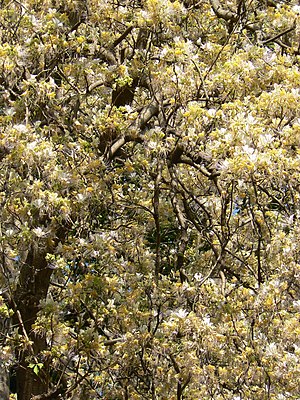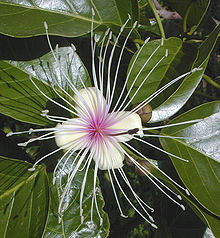Crateva religiosa
| Crateva religiosa | ||||||||||||
|---|---|---|---|---|---|---|---|---|---|---|---|---|

Crateva religiosa |
||||||||||||
| Systematics | ||||||||||||
|
||||||||||||
| Scientific name | ||||||||||||
| Crateva religiosa | ||||||||||||
| G. Forest. |
Crateva religiosa is a species of plant that belongs to the caper family (Capparaceae). It is widespread in the tropical zones of Asia. It has locations in China , Taiwan , Bhutan , Nepal , Myanmar , Thailand , Cambodia , Vietnam , India , Sri Lanka , Indonesia , the Philippines and the Pacific Islands.
description
Vegetative characteristics
Crateva religiosa grows as a deciduous tree that can reach heights of 3 to 15 meters and a trunk diameter of 40 centimeters ( BHD ). The parts of the plant have no hairs ( trichomes ). The bark of the branches is light green to yellowish green when dry with gray elongated lenticels .
The alternate leaves are arranged in a petiole and a leaf blade. The usually 6 to 7 (5 to 10) cm long leaf stalks have tiny triangular glands near the rachis . The imparipinnate leaf blades are composed of three leaflets. The leaflets have an initially thin, later thicker, usually 3 to 5 (rarely up to 7) mm long stalk. The thin and leathery leaflets are usually 5.5 to 7 (4 to 10) cm long and (rarely 2 to) 3 to 4 cm wide, two to two and a half times as long as they are wide. There are five to ten lateral nerves on both sides of the reddish middle nerve, and the network nerves are also clearly visible. The terminal leaflet has an asymmetrical base. The stipules are small and triangular.
Generative characteristics
At the ends of new branches, on which fewer leaves are formed just below the flowers, there are umbrella or raceme inflorescences with 10 to 25 flowers. After the flowering period, the inflorescence axis is somewhat longer and clear scars remain on it after the flowers have fallen off. The bracts, which fall off early, are leaf-like or narrow and 0.8 to 1.5 cm long.
The flower stalks have a length of 2 to 5 cm. The flowers open between March and May before the leaves unfold. The mostly hermaphrodite flowers are more or less radial symmetry and four-fold with a double perianth . The four egg-shaped, greenish sepals have a length of 2 to 4.5 mm and a width of 1.5 to 3 mm. The four white to yellow petals are 3.5 to 5 mm long, keeled and the petals are 1.5 to 2.2 cm long. There are usually 16 to 22, rarely up to 30 stamens present, with 3 to 6 cm long stamens that are fused together at the base 1 to 4 mm long and 2 to 3 mm long anthers. A gynophore 3.5 to 6.5 cm long is formed. Fused stamens and gynophore together form an androgynophore . The above constant, unilocular ovary is mm and a length of 3 to 4 to a diameter of 1 to 2 mm oval to nearly cylindrical. There are many ovules . There is a nectarium.
Egg-shaped to obovate, 1.8 to 2.6, rarely up to 3.5 cm long berries are formed, which hang down on stems and contain 25 to 50 seeds. The leathery, 5 to 10 mm thick pericarp is gray to dust-colored with almost circular, ash-yellow spots. The dark brown seeds are 1.2 to 1.8 cm tall and warty. The fruits usually ripen between July and August, sometimes until October.
The number of chromosomes is 2n = 26.
ecology
Crateva religiosa can plant galls train passing through the Fly Neolasioptera crataevae be induced.
Visitors of Crateva religiosa are mostly honeybees , but also by a moth from the superfamily of gelechioidea , the monarch butterfly , the Great Kohlweißling , of wasps from the family of wasps and even birds such as the Rose-ringed Parakeet or of birds from the family of sunbirds is Crateva Visited religiosa .
Systematics
This species was written in 1786 with the spelling Crataeva by Johann Georg Adam Forster in dissertation ... De Plantis Esculentis Insularum Oceani Australis , pp. 45-46 and in the same year in Fl. Ins. Austr. , P. 35 with a brief description published. The spelling Crateva religiosa is valid.
Others
Crateva religiosa has religious significance among Hindus in northern India. Plant parts are also used in Ayurvedic medicine .
The fruits, which are considered poisonous, are sometimes eaten roasted.
The place Ibusuki has chosen Crateva religiosa as a symbolic plant. In India it was already a stamp motif.
swell
- Mingli Zhang & Gordon C. Tucker: Capparaceae in the Flora of China , Volume 7, 2008, 435: Crateva religiosa - online (sections description, distribution and systematics).
- H. Panda: Handbook On Medicinal Herbs With Uses. Asia Pacific Business Press, Delhi 2004, ISBN 81-7833-058-X , Crataeva Religiosa pp. 396-397.
- Shashi Bala Sharma, Anita Rana, SVS Chauhan: Reproductive biology of Crataeva religiosa Forst. (PDF) (section ecology).
Individual evidence
- ^ Crateva religiosa at Tropicos.org. Missouri Botanical Garden, St. Louis
- ↑ Mark Stebbins: Flowering Trees of Florida. Pineapple Pr Inc, 1999, ISBN 978-1-56164-173-4 , limited preview in Google Book Search, Crateva on p. 66.
Supplementary literature
- S. Sahoo, SK Mishra, PK Panda et al .: Antimycotic Potential of Cratavea Religiosa Hook and Forst Against Some Selected Fungal Pathogens. (PDF; 39 kB), In: Acta Poloniae Pharmaceutica - Drug Research . 65 (2), 2008, pp. 245-247.
Web links
- Crateva religiosa at Useful Tropical Plants.



